Not a whole lot of folks in this space know this about me, but I actually was born abroad in the Philippines. I spent the first part of my childhood growing up in Manila and visit at least once a year since both my parents retired there. Filipino food has a special place in my heart, and in some ways, shaped my diet today. My staple grain of choice is white rice, my vegetables of choice are usually stir fried Asian-style in some sort of soy sauce/fish sauce situation, and there is nothing more comforting to me than a bowl of Filipino adobo.
That being said, Filipino desserts were never really my jam. With the exception of leche flan (of course, my grandmother made the best one from scratch, without a formal recipe or even measuring any ingredients), I was never really fond of any Filipino desserts. There are a lot of different kinds of Filipino desserts and sweets, but the ones I most vividly remember were rice-based and too gelatinous, dense, and sticky for my childhood self. Most Filipino desserts are also flavored with tropical fruits and roots like coconut, ube, cassava, jackfruit, and mango. Maybe it was just a case of the grass being greener on the other side, but my childhood self instead wanted the exact opposite: Western desserts. Airy cakes made with vanilla and chocolate, crumbly shelf-stable cookies, and super artificial candy like Fruit by the Foot.
I thought that as I grew older, I would become more fond of Filipino desserts. But it never happened. My feelings towards Filipino desserts remained neutral at best, indifferent at worst. What did happen though, was a gradual but burgeoning interest in the flavors often used in Filipino sweets. Like ube. Ube is a purple yam frequently used in Southeast Asian desserts; a lot of folks get it confused with taro or purple sweet potatoes, but it’s actually its own variety of root vegetable. It has a mild, sweet flavor, but a vivid purple color to make baked goods stand out a mile away.
Although ube is frequently used in desserts in Asian restaurants and snack shops, I was really inspired to see my friend Autumn use it in more Western desserts at the establishments that she and her husband owned in my old neighborhood in Brooklyn. Her husband would serve ube kolaches (a Czech pastry popular in Texas, where Autumn is from and I went to high school) at his bar and her bakery, and her cookie delivery service featured ube crinkle cookies on its menu. Autumn inspired me to make a blog-related resolution for this year: to use more Filipino flavors in Western desserts. By the end of the year, I’m hoping to have more dessert baked goods featuring some of the flavors of my childhood. And I’m starting with these ube cinnamon rolls — the ube not only gives them a beautiful, vibrant look, but also pairs wonderfully with the cinnamon for a unique, fusion baked good. Enjoy!
-
- To make these rolls, you’ll need two sources of ube: ube halaya jam and ube extract. Ube halaya jam is available online, and can usually be found in the Filipino/Hawaiian aisles of an Asian supermarket (Portlanders — I bought the Monika brand at Fubonn, but I also saw some available at Uwajimaya). Ube extract is trickier to source in real life, but can easily be purchased online (I used the McCormick brand). You can always substitute ube extract with vanilla extract, but note that your rolls won’t be as vibrantly purple as mine (since the extract contains purple food coloring). It won’t likely be as flavorful either since ube halaya jam has a pretty subtle taste.
-
- Speaking of which, because ube is such a subtle taste, some folks who’ve tried the cinnamon rolls suggested omitting the cinnamon for a stronger ube flavor. I made these rolls a handful of times, omitting the cinnamon during one trial. It’s good! But definitely less fusion-y. So if you want a true cinnamon roll, stick with the cinnamon. But for ube lovers, go wild and commit fully to the ube and omit the spice.
- Depending on how you roll the dough, it’s likely that you’ll end up with more rolls than can fit in the pan. If you’re baking the rolls in a 10-inch cast iron pan like I did, I recommend only placing 5 buns in the pan — it makes for a more attractive mega-bun, and crowding too many rolls in a pan might cause them to expand upwards rather than sideways. You can bake any additional rolls on a sheet pan; just be sure to leave enough space between them to allow them to expand properly when baking.
Get the Recipe: Overnight Ube Cinnamon Rolls
Ingredients
For The Buttermilk Dough
- 3 ½ cups (15.75 ounces) all-purpose flour
- 3 Tablespoons granulated sugar
- 1 ½ teaspoons instant yeast
- ½ teaspoon baking soda
- 1 teaspoon kosher salt
- 1 cup (8 fluid ounces) buttermilk, warmed to 120 (F) – 130 (F)
- 1 large egg, at room temperature
- ¼ cup (2 fluid ounces) vegetable oil
For The Ube Filling
- ¼ cup (2 ounces) ube halaya jam
- ¼ cup (2 ounces) crème fraîche
- 2 Tablespoons granulated sugar
- 2 teaspoons ground cinnamon
- 1 teaspoon ube extract
- pinch kosher salt
For the Crème Fraîche Glaze
- 3 Tablespoons (1.5 ounces) crème fraîche
- 1 Tablespoon whole milk
- 1 teaspoon pure vanilla extract
- ¾ cup (3 ounces) confectioners’ sugar
Instructions
- In a large bowl, whisk together 3 1/2 cups all-purpose flour, 3 tablespoons granulated sugar, 1 1/2 teaspoons instant yeast, 1/2 teaspoon baking soda, and 1 teaspoon kosher salt. Set aside.
- In a large liquid measuring cup, whisk together 1 cup buttermilk (warmed to lukewarm — remember that yeast is a living thing, so it's important not to kill it by warming the liquid too much; you want the temperature to be similar to that of a warm bath and no more), 1 large egg, and 1/4 cup vegetable oil. Set aside.
- Use a tall cup or a large measuring cup to make a well in center of the dry ingredients (from the 1st step) and add liquid ingredients (from the 2nd step), using a wooden spoon or a rubber spatula to stir until combined. As the dough starts to form, transfer to a lightly floured counter and knead for 10 minutes until the dough is smooth and elastic. If the dough is sticking, you can add up to 1/2 cup of extra flour as you knead, but don't over do it.
- Transfer the dough to a greased bowl, cover with plastic wrap, and refrigerate overnight, until the dough has doubled in size.
- Once the dough has doubled in size, transfer to a lightly floured counter and use a rolling pin to roll into a rectangle about 12 x 20 inches. Pro tip — the longer your rectangle, the more attractive your rolls will be! Try and make that 20 inches work.
- In a small bowl, whisk together 1/4 cup ube halaya jam, 1/4 cup crème fraîche, 2 tablespoons granulated sugar, 2 teaspoons ground cinnamon, 1 teaspoon ube extract and a pinch of salt until well combined and a homogenous purple color. Use an offset spatula to spread the ube mixture over the rolled dough. For more attractive rolls, make sure you spread the filling completely and evenly over the rolled out dough, including the edges.
- Working widthwise, roll the dough into a log, pinching its edges to seal. Cut the roll into 7 to 8 pieces, each about 2 inches wide. Place cut sides down on a 9-inch, deep dish pan in a flower shape. Cover with plastic wrap and let rise in a warm place until the edges of the roll are rounded and touching, about 1 to 1 1/2 hours.
- Once the rolls have risen, preheat the oven to 350 (F). Bake the rolls in the preheated oven for around 30 to 35 minutes, or until the edges of each bun are golden in color. The best way to do so is to stick a skewer inserted in the center bun and see if it comes out clean, without any dough. If the tops of the rolls start to brown too quickly, cover with aluminum foil and continue baking until a skewer comes out clean. Let cool on a wire rack.
- While the rolls are cooling, make the glaze. Combine 3 tablespoons crème fraîche, 1 tablespoon whole milk, and 1 teaspoon pure vanilla extract in the bowl of a freestanding electric mixer fitted with a paddle attachment and beat on a low speed until combined. Add 3/4 cup confectioners' sugar all at once and beat until fluffy and of drizzling consistency. Use immediately to drizzle on top of each cinnamon roll while the rolls are still warm, using a rubber spatula or butter knife to spread out the glaze.

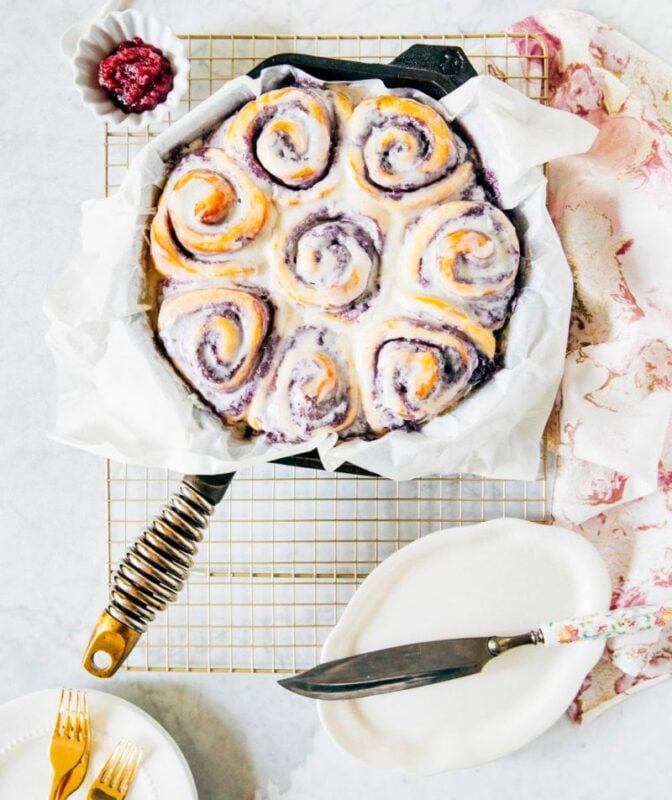
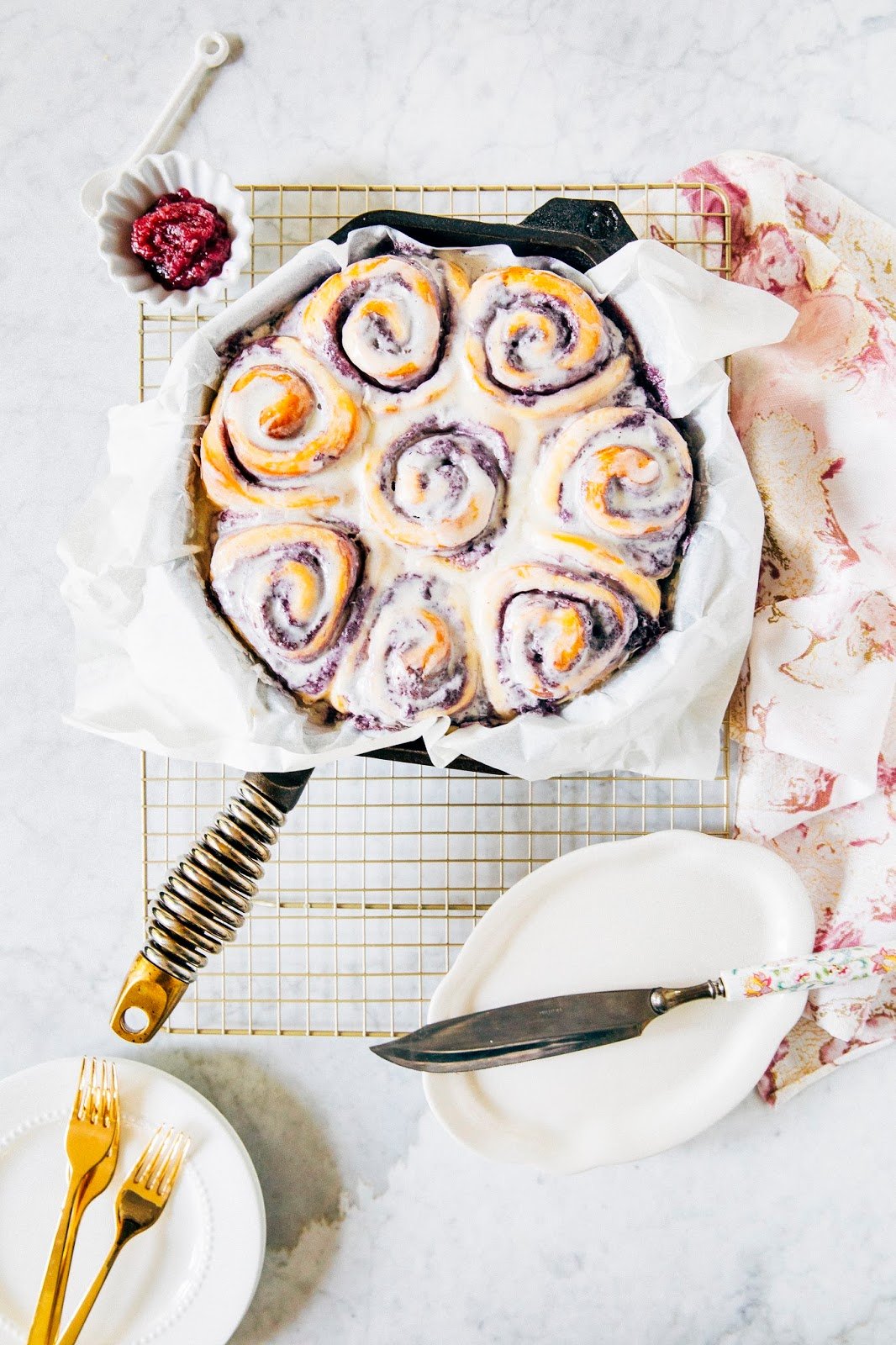
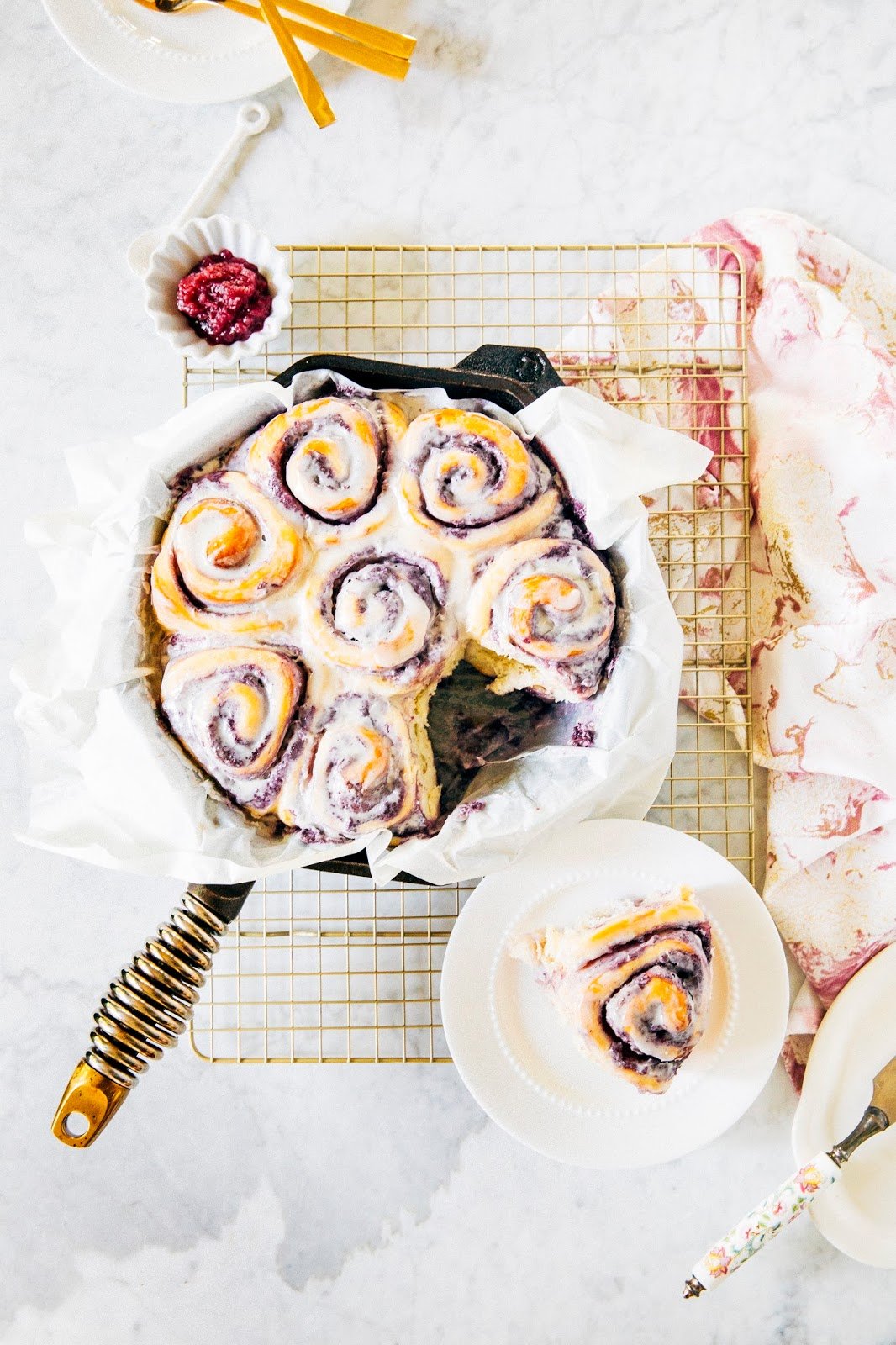
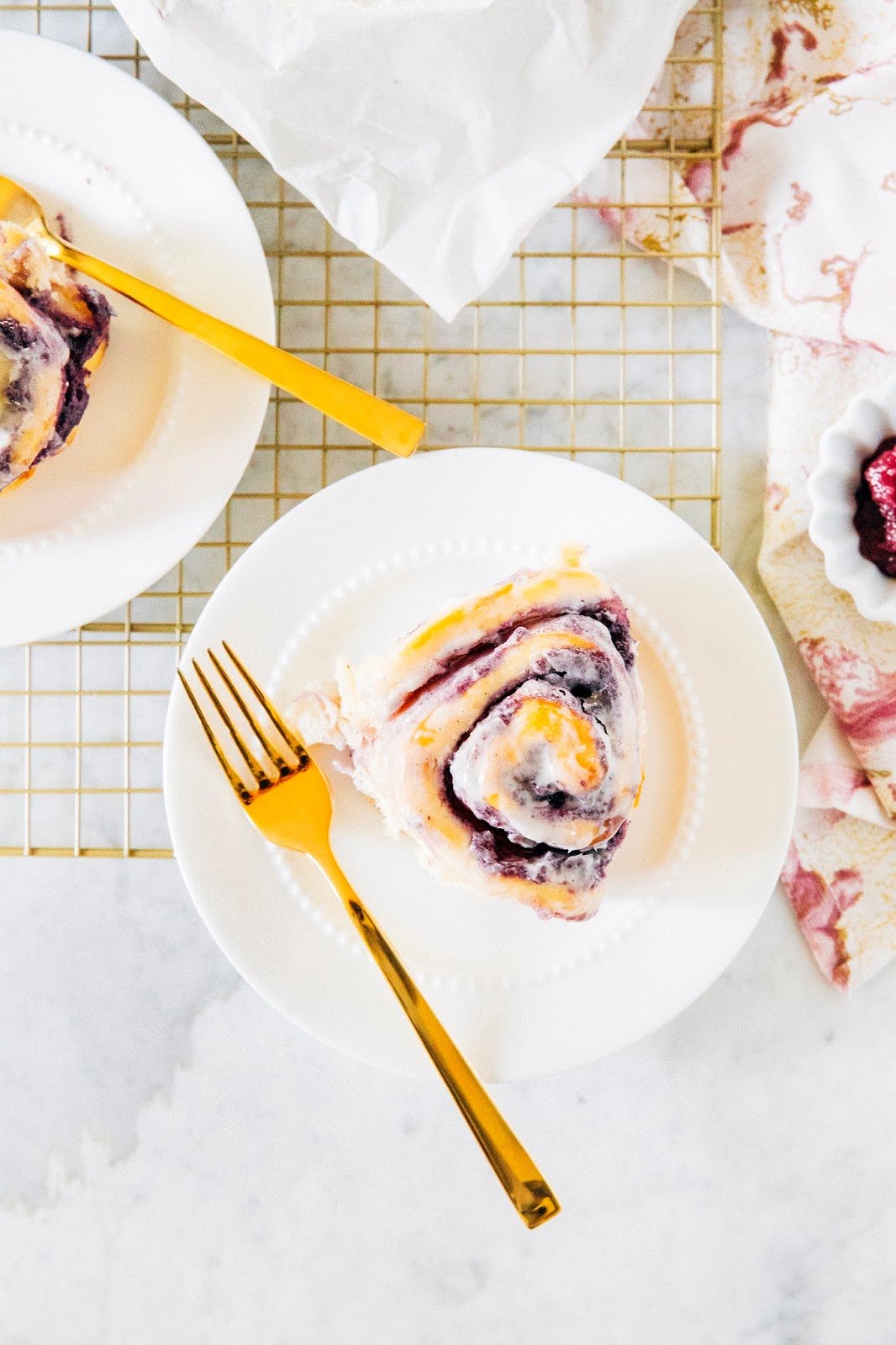
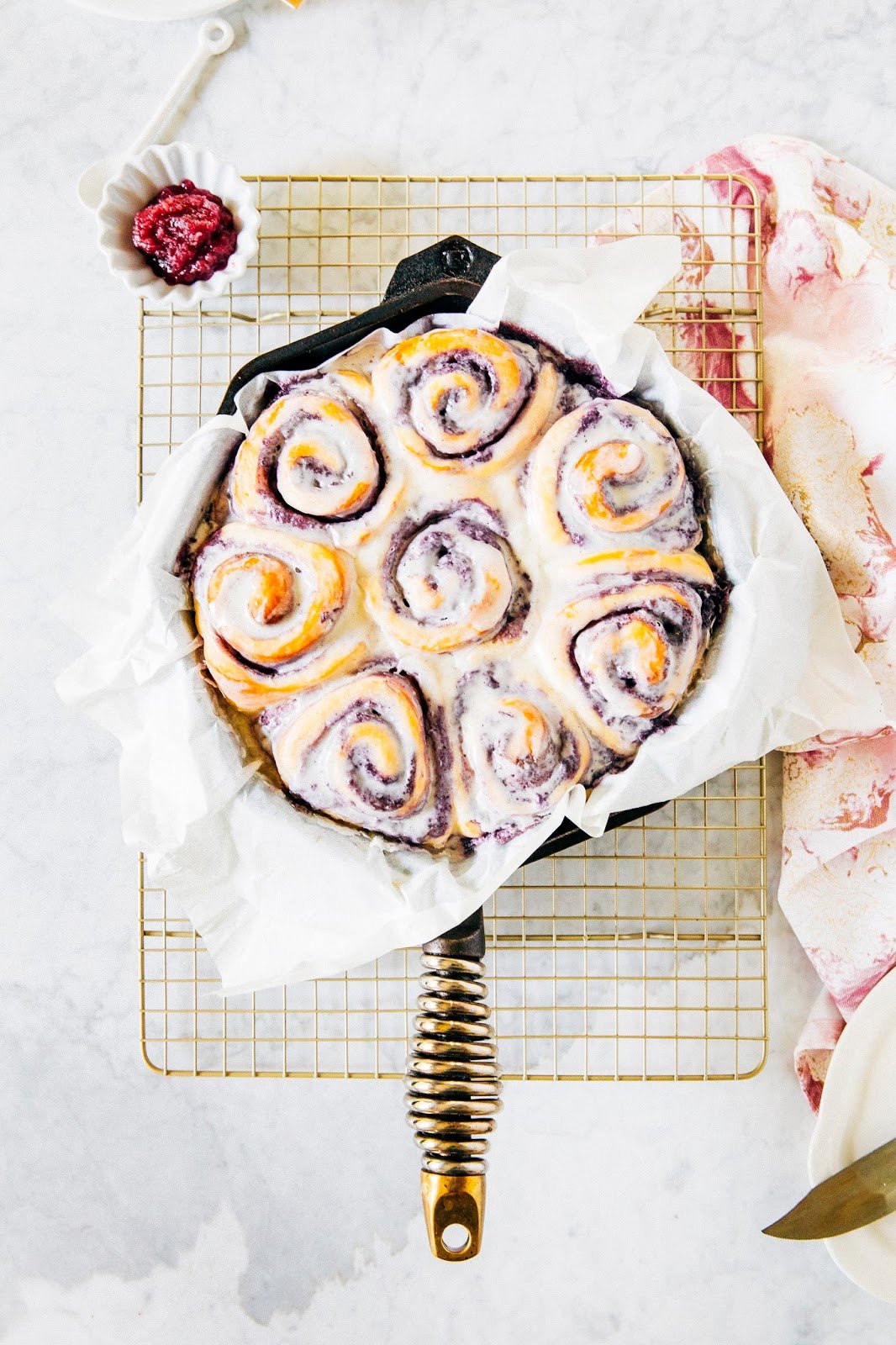
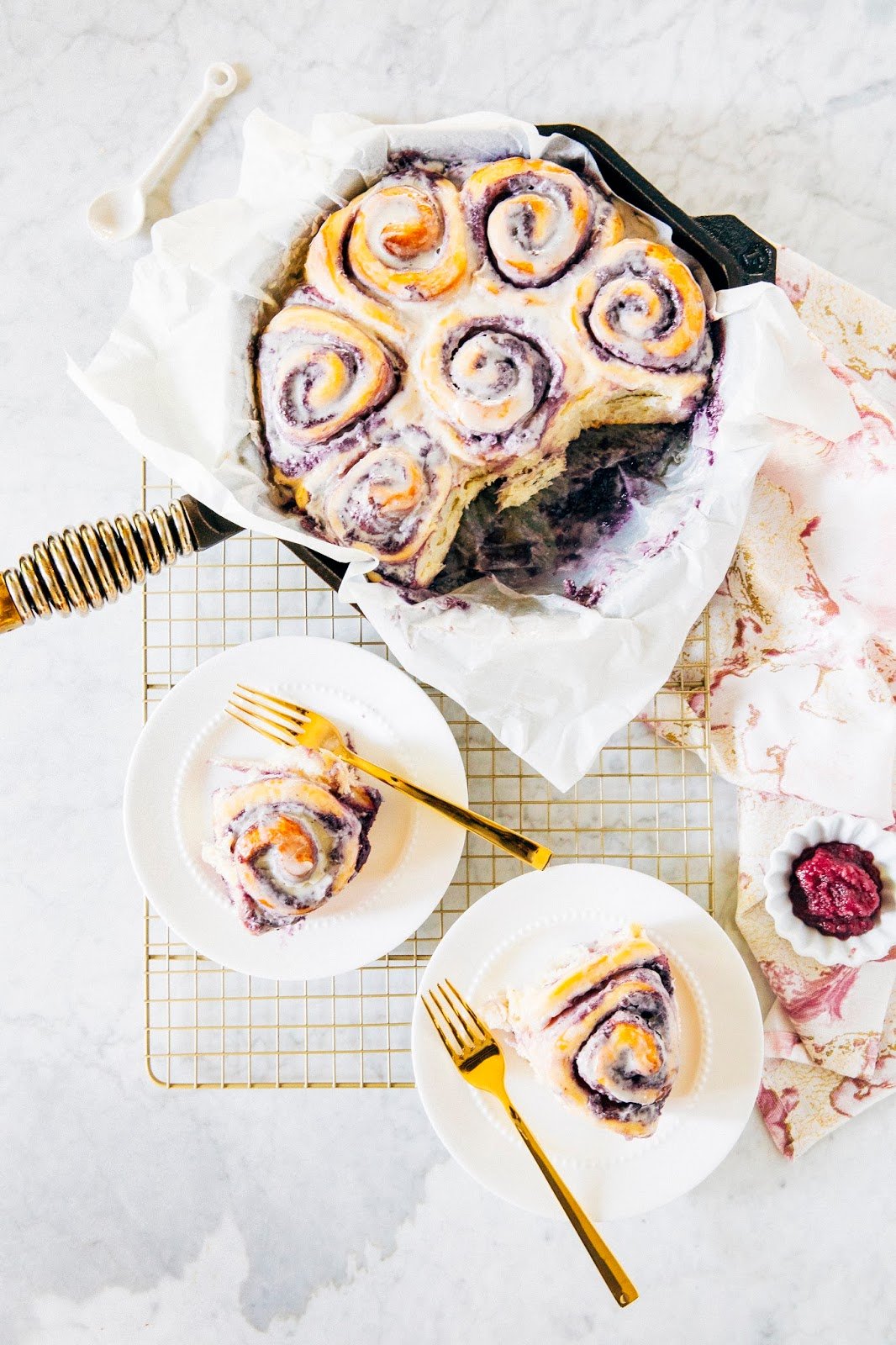
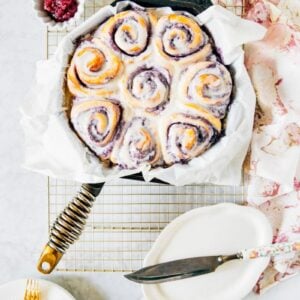

Hi my name is April …..I enjoyed reading your story ! I love to bake with Ube …I’ve made wonderful icecream and my own ube jam ( although I’ve had to use Okinawan sweet potatoes) have shopped at both the stores you mentioned 🥰 I lived on Hawaii for many years and love to bake mochi for all our mainland friends ! I’m going to make your rolls and take them to the coast at the end of July. Also some ube cookies too!
Can I bake this in two 8 inch round cake pans?
Hi there! What can I use in the absence of crème fraîche? TIA!
Hi! You can use sour cream or cream cheese instead!
It was extremely delicious. And the foiling to keep the tops of the cinnamon rolls from burning is VITAL. I’m so proud of what I made that I’m driving some to friends and family to try 💜